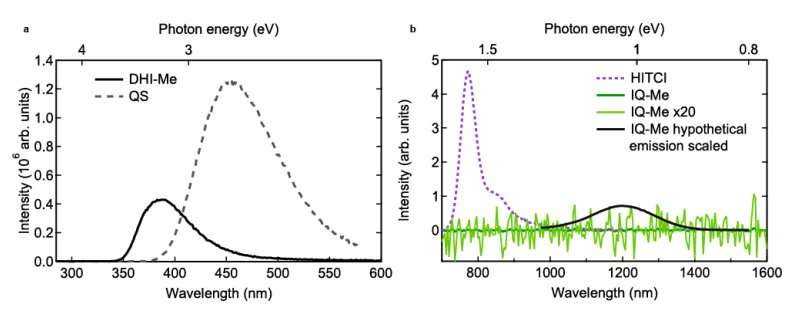This article has been reviewed according to Science X's editorial process and policies. Editors have highlighted the following attributes while ensuring the content's credibility:
fact-checked
peer-reviewed publication
trusted source
proofread
Newly revealed properties of melanin 'ingredient' could advance bioelectronics

After nearly a century of scientific inquiry, scientists have at last been able to characterize a key component in the substance responsible for giving countless living organisms their color.
In the study, published online today in the journal Nature Chemistry, an international team of researchers isolated a key molecule involved in the synthesis of melanin, a substance in the human body that produces pigmentation in the hair and skin and protects cells from being damaged by ultraviolet radiation from the sun. The molecule they studied has many of the physical properties of eumelanin, a type of melanin that typically produces only black and brown pigments.
Despite what researchers know about melanin, its chemical structure has remained elusive, said Bern Kohler, an Ohio Eminent Scholar and professor of chemistry and biochemistry at The Ohio State University, one of three senior authors on the study.
"Melanin is literally as plain as the nose on our face and we still don't know exactly what it's made of and how it works," said Kohler. "It's thought to be a material made of large numbers of interacting components, and so what my collaborators and I are trying to get at is, what are melanin's underlying chemical units and what are the interactions that give rise to its properties?"
In the lab, melanin can be made naturally from just a few simple chemical substances that combine or react to form the pigmented material. Thanks to the efforts of Jean-Philip Lumb of McGill University and Lluis Blancafort of the University of Girona, the team was able to successfully synthesize and analyze one of its molecule-sized ingredients. They found that it had many of the same properties as the final product melanin, even without further transformation.
"Melanin is like a complex dish that you cook from just a few ingredients," said Kohler. "Given that melanin granules in skin contain billions of atoms, it was surprising to see melanin-like properties emerge in a molecule containing only a few dozen atoms."
As a spectroscopist—or a scientist who investigates the interactions between matter and light—Kohler said what he finds most remarkable is the brilliant green color of the melanin-like molecule, which is able to absorb deep red light.
"That's very hard for a small molecule to do," said Kohler. "This is one of the smallest organic molecules known that can absorb long wavelengths all the way out into the infrared."
Its unusual optical and magnetic properties make the melanin-mimicking molecule an attractive prospect for advancing bioelectronics research, a field that aims to connect electronics and living biological materials to fabricate new technologies or therapies for medical treatments, said Kohler.
The study results also suggest that harnessing the power of melanin could be used to change the way humans harvest energy from our environment.
"Like solar energy conversion, part of our strategy for alternative energy is to absorb photons of light from across the solar spectrum," Kohler said. "That's what eumelanin does, rather naturally."
Future research will aim to study melanin-like properties in similar kinds of molecules. Such strides could offer greater accessibility to synthetic biomaterial alternatives, but in the short term, Kohler imagines the team's work uncovering a melanin-like molecule will inspire other labs to look more closely at how melanin's properties may emerge from other unexpectedly small molecular units.
"Our team is excited that further progress at understanding the structure of melanin can succeed by studying tailorable small molecules like the one we write about in this paper," he said. "The chemistry is still tremendously complex, but interest should grow in small molecules as melanin models and the promise they hold for generating new, melanin-inspired materials."
More information: Xueqing Wang et al, Indole-5,6-quinones display hallmark properties of eumelanin, Nature Chemistry (2023). DOI: 10.1038/s41557-023-01175-4
Journal information: Nature Chemistry
Provided by The Ohio State University





















